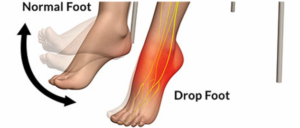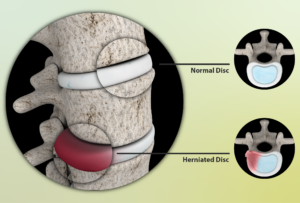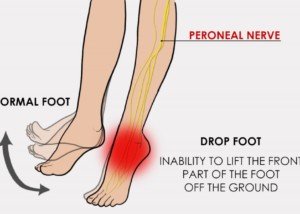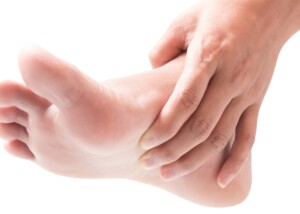
There are 11 benign causes of foot drop, but there are also more serious conditions including five that can kill you.
If you’ve been noticing what seems to be foot drop in one of your feet, you may have then subsequently learned that the deadly ALS causes this symptom.
You may then be wondering: If it’s not ALS, can it be another life threatening or very serious neurological disease?
Maybe you’re also wondering if any benign conditions can cause foot drop.
If your anxiety is bad enough, then every stubbed toe, difficulty getting on a shoe, foot slipping off the pedal of a stationary bike or in your car – every little nuance in your foot will mean foot drop.
Nevertheless, there are numerous causes for foot drop other than ALS.
Some can kill you, while others are easily remedied, while still others will be chronic but not life threatening.
The Peroneal Nerve
“The common peroneal (sometimes called fibular) nerve courses around the neck of the fibula bone,” says Dr. David Beatty, MD, a retired general practitioner with 30+ years of experience and an instructor of general medicine for 20 years.
“This is the prominent bit of bone on the outside of the leg just below the knee.
“This nerve supplies the muscles of the front and outside of the lower leg which are responsible for moving the foot upwards (dorsiflexion).”
The foot is moved upward when you walk, trim your toenails and switch pedals when driving.
In foot drop, dorsiflexion is impaired or not possible.

Benign Causes of Foot Drop
In these cases, “benign” means that the condition won’t shorten your life, won’t lead to a motor neuron disease and may even resolve quite easily. However, a few of these canditions can be very painful.
Leg crossing if habitual. “Pressure on the nerve from persistently crossing the legs can cause a temporary foot drop,” says Dr. Beatty.
Yoga. Pressure from various positions (namely prolonged sitting on the heels) can irritate the peroneal nerve.
Bungee jumping. Pressure from the cord can cause peroneal nerve palsy.
Weight loss: significant. The rapid reduction of the fatty protective cushion around the peroneal nerve can cause palsy.
Knee dislocation. “The most common type is when the kneecap is displaced laterally towards the outside of the knee,” says Dr. Beatty.
“It’s usually associated with swelling and inflammation that can put pressure on the common peroneal nerve.
“More serious dislocations at the articulations of the femur, tibia and fibula are more likely to be more damaging to the nerve.”
Sciatica or lumbar disc herniation. “This can cause pressure on the sciatic nerve,” says Dr. Beatty. “This nerve divides into the common peroneal nerve and the tibial nerve near the knee.”

Herniated disc. Myupchar. com
Chronic exertional compartment syndrome. The acute version can cause permanent muscle damage, but chronic cases are more easily resolved. CECS is caused by exercise and affects muscles and may impair peroneal nerve function.
Spinal stenosis. This is a narrowing of the spinal canal. There is no cure, is progressive, but sufferers may live into their 90s. Some cases are treated with surgical decompression.
Lumbar synovial cyst. “Like a disc herniation this can put pressure on the sciatic nerve,” says Dr. Beatty.
Pelvic hydatid cyst. “This rare condition causes a cystic swelling arising in the bone of the pelvis,” says Dr. Beatty. “If this swelling presses on the sciatic nerve it may cause foot drop.”
Anterior tibialis tendon rupture. The anterior tibialis is the main muscle in the front of the lower leg, responsible for dorsiflexion.
Potentially Deadly Causes of Foot Drop other than ALS
Diabetes. Dr. Beatty explains, “Diabetes can cause neuropathy when one or more nerves are damaged. If the common peroneal nerve is affected the person may not be able to lift the foot upwards.”
Meningioma. A benign tumor of the meninges, it can encroach upon the brain and for that reason is considered a brain tumor.
DVT. “With a blood clot in the deep veins of the leg, there is usually swelling below the level of the clot,” says Dr. Beatty.
“This swelling may compress either the sciatic or common peroneal nerves, affecting foot dorsiflexion. It’s often painful behind the knee when the foot is dorsiflexed if a DVT is present (Homan’s sign).”
A DVT can break off, travel to the lungs and be fatal.
Stroke. Some strokes are very small, but having a small stroke means you’re at high risk for a future massive stroke without medical management.
Foot drop from stroke is extremely rare, but when it happens, it’s sudden.
Lymphoma (type of cancer) of the sciatic nerve; is extremely rare.
Brain tumor metastasis from a distant primary site such as the lungs
Neurofibromatosis. A genetic disorder, usually diagnosed in childhood, that a person may not know they have until they’re a young adult and symptoms are bothersome enough to seek medical evaluation. Benign tumors form on nerve tissue.
Dr. Beatty adds, “I know of one person who was left with a foot drop after suffering from polio.
“This emphasizes the importance of vaccinating against a disease we rarely see in the Western world.”

 Dr. Beatty has worked in primary medicine, surgery, accident and emergency, OBGYN, pediatrics and chronic disease management. He is the Doctor of Medicine for
Dr. Beatty has worked in primary medicine, surgery, accident and emergency, OBGYN, pediatrics and chronic disease management. He is the Doctor of Medicine for 
























